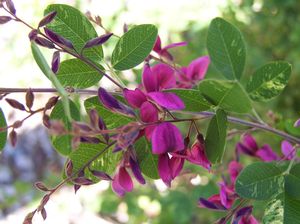Printed at http://www.quackingrassnursery.com/index.cfm/
Lespedeza thunbergii 'Spilt Milk'
Bush Clover
Plant Type:
DECIDUOUS SHRUBSLespedeza thunbergii ‘Spilt Milk’ – 'Spilt Milk' is a variegated form with creamy-white splashes and streaks on all the blue green foliage. ‘Spilt Milk’ flowers with vibrant pink-purple flowers in September on stems that gracefully arch. This lovely variegated form is not as vibrant as its solid green siblings; that is evident in pots but once established in the ground it is perennial. Spring planting is advised in the northern part of its range. 'Spilt Milk' is late blooming in the Bush Clover season.
Characteristics and Attributes for Lespedeza thunbergii 'Spilt Milk'
Season of Interest (Flowering)
- Late Summer / Autumn
Season of Interest (Foliage)
- Spring / Summer / into Autumn
Nature Attraction
- Honey Bees & Native Bees
Light
- Full Sun
- Mostly Sunny
Attributes
- Natural Garden
- Border
- Drought Tolerant
- Shrub Border
- Specimen
- Hedge
- Wildlife Garden
- Hedgerow
Growth Rate in the Garden
- Moderately Fast
Soil
- Draining
- Fertile
- Average
Origins
- Garden Origin
Propagated By
- Cutting Grown
Genus Overview: Lespedeza
Common Name: Shrub Bush Clover
We have great affection for the Bush Clovers. A soft looking shrub cloaked in clean blue green trifoliate leaves on stems that gracefully arch; vase-shaped earlier in the season the tendency for the semi-woody stems is to gently weep as the season progresses. They bloom on new wood during late season with amazing displays of pea flowers. We treat Bush Clover as an herbaceous perennial in the north, cutting it down to 2” stubs at the end of winter before new growth emerges. They are fantastic with Miscanthus, perennial sunflowers, Joe-pye weeds, butterfly bushes, ironweeds, asters and just plain beguiling with late blooming daylilies – oh, heck: they look great with anything and everything that blooms in the late season garden. Site them in full to nearly full sun planted in fertile draining soil where they will gradually increase their girth with each new annual flush of growth. All of the following offerings are cutting grown.



